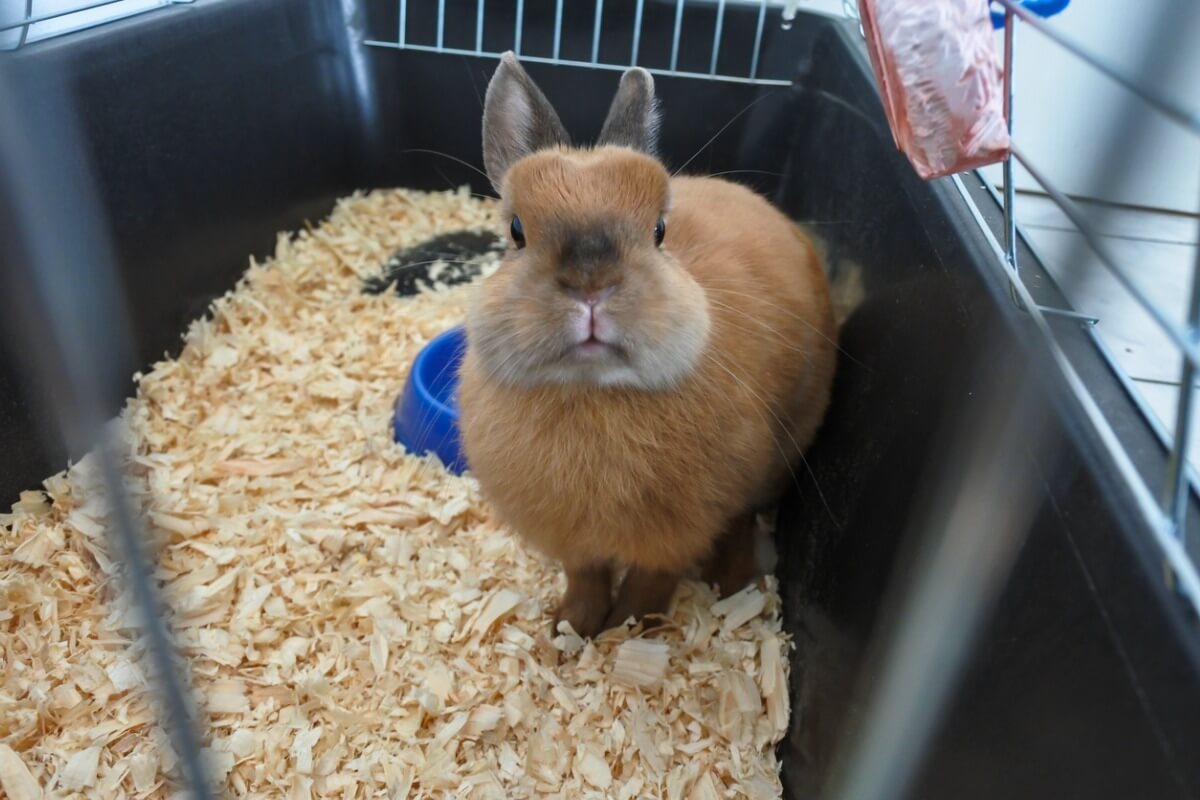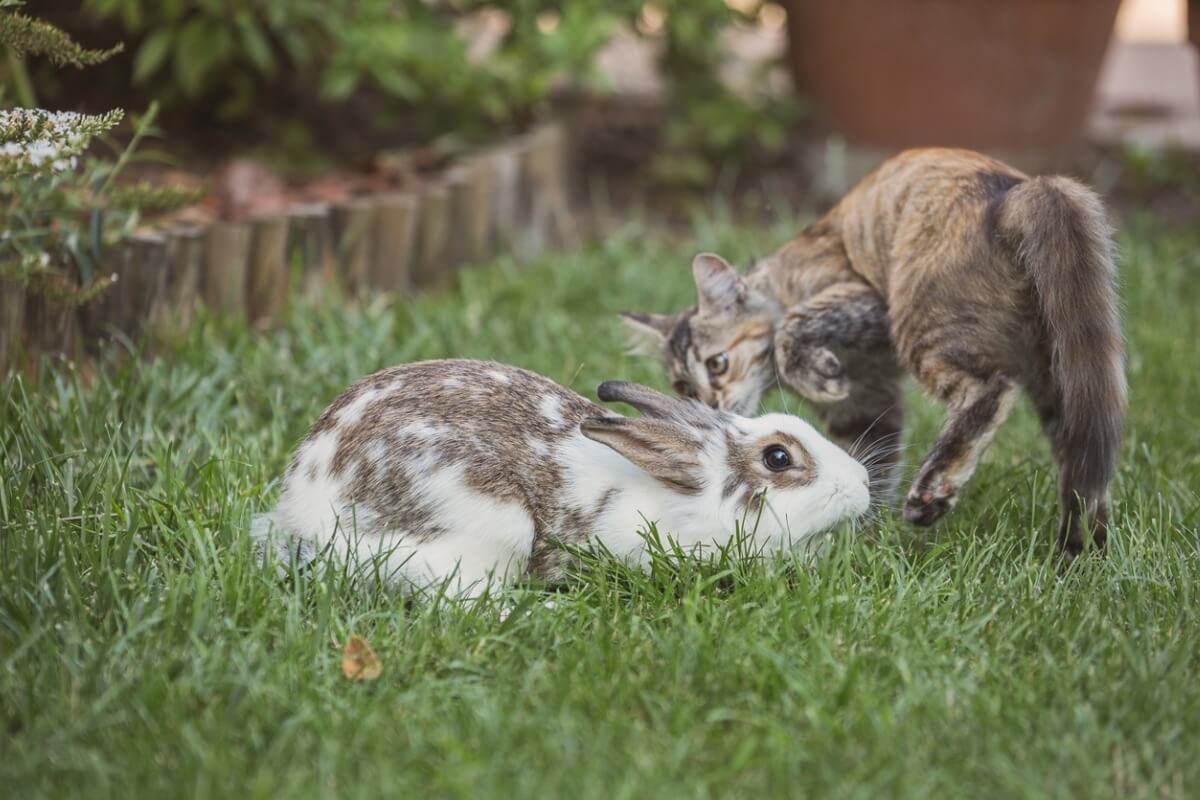Can Cats and Rabbits Live Together?


Reviewed and approved by the biologist Samuel Sanchez
Do you think that cats and rabbits can live together? It seems a very unlikely combination, as one is an excellent predator and the other is prey. However, the peculiarities of their coexistence will surprise you.
Cats and rabbits have very different social relationships, as some live in groups and others are solitary. Even so, this doesn’t mean that they aren’t able to live together in the same home, as you’ll discover in the following lines.
Cats and rabbits
Can cats and rabbits live together? Yes, and not only that, but they’re also capable of being friends. This is a common combination in homes and it’s very rewarding for the owners, according to House Rabbit Society. The most important thing is to eliminate the predator-prey stereotype and know how to introduce these two animals to each other to avoid stressing them out.

And where is the instinct?
A cat that lives with a young rabbit can stalk and chase another rabbit in the open air because the environment activates its hunting instinct. In fact, it even tends to chase the same rabbit it lives with if the interaction takes place outside the house.
In order for cats and rabbits to live together, it’s crucial to ensure an environment in which it’s unlikely that the cats will feel stimulated and show their more predatory nature.
Although it may be hard to believe, rabbits tend to be more confrontational than cats when it comes to social relationships. This is because they live in groups and are, therefore, more concerned with hierarchy. They’re also prey animals who distrust absolutely everything that doesn’t belong to their species.
However, domestication plays a fundamental role as regards instinct, as it modifies many types of behavior. Some cats prefer to live with at least one other cat and there are even animals that seek the company of other species different from their own. On the other hand, some rabbits prefer to be close to a kitten rather than to be with another of their own species.
How does the coexistence between cats and rabbits begin?
The rabbit may run away from the cat, and, if this happens, the instincts of the rabbit will communicate something very different to social coexistence. You should know how to manipulate the environment because felines tend to hunt at the slightest opportunity and can harm the animal with their claws if they perceive it as a toy.
Regardless of how friendly the feline is, make sure that the sharp, curved tips of its claws aren’t there. A reputable veterinarian will be able to show you how to perform this procedure properly. Be careful, as a single light swipe of a claw will give your bunny a scratch that can later turn into a serious injury.
The first step
Another very important point when introducing cats and rabbits is that the latter should have access to a cage as its safe place. Make sure that the feline’s paws don’t fit through the bars. Also, give the rabbits a hiding place inside your house, such as a cardboard box.
The main advantage of giving them space is that, while the rabbit is in its cage, the two animals will have a chance to get used to each other’s smells, sounds, and movements. The scenario is even better if the rabbit can go out to run around in its own cage because, in this way, the cat will get used to its activity without being able to reach it.
This phase can take days, weeks, or even months, depending on the personality of both animals. Don’t rush things; it’s better to go slow and succeed than to exert pressure, generate stress, and resort to scolding (the least effective method in feline education).
Scolding teaches the cat to wait for the humans to leave the room and then torment the rabbit.
The next step so that cats and rabbits can live together
When you feel it’s time, go ahead and put the two animals together while you supervise them. Spend some time with them in a room where you can intervene if absolutely necessary, but, ideally, give them a chance to work things out in their own way.
If the cat is respectful and curious, let it sniff around and investigate the environment. If it’s boisterous, spray it with water a few times as a distraction (trying not to let it know that you’re the one spraying it, otherwise it would make a negative link between you and the water).
If you have to resort to water frequently, it means that you have moved on too soon and must go back to the first step (the cage phase). Don’t lose hope, as, after a variable period of time, most rabbits and cats get used to each other. It’s only a matter of time and, in some cases, proper supervision.
Another scenario is when the rabbit chases the cat and the cat runs away. The majority of rabbits only run after the cat until they feel they’ve expressed their displeasure; this behavior doesn’t require human intervention. Once both have relaxed, the two animals can become peaceful companions, or even friends.
A new resident
If you introduce a rabbit to a cat who already lives in the home, you may need to give the rabbit time to establish a sense of territory before it meets the feline. At first, it’s usually a good idea to confine the new animal (whether it’s a kitten or a rabbit) to a small area (a cage or a single room).
Change is stressful for both rabbits and humans. Arriving in a new home is more than enough stress for a rabbit, so don’t put it in the position of having to get used to new territory, the presence of humans, and interaction with cats all at once. Wait until the animal feels safe and comfortable before you move forward.

The most important part of this process is to understand what the cats and rabbits are telling you with their body language, especially regarding their stress levels during the interaction. Let them set the pace of this process, as it’s worth the effort and patience to build a place where they can both live in peace.
Do you think that cats and rabbits can live together? It seems a very unlikely combination, as one is an excellent predator and the other is prey. However, the peculiarities of their coexistence will surprise you.
Cats and rabbits have very different social relationships, as some live in groups and others are solitary. Even so, this doesn’t mean that they aren’t able to live together in the same home, as you’ll discover in the following lines.
Cats and rabbits
Can cats and rabbits live together? Yes, and not only that, but they’re also capable of being friends. This is a common combination in homes and it’s very rewarding for the owners, according to House Rabbit Society. The most important thing is to eliminate the predator-prey stereotype and know how to introduce these two animals to each other to avoid stressing them out.

And where is the instinct?
A cat that lives with a young rabbit can stalk and chase another rabbit in the open air because the environment activates its hunting instinct. In fact, it even tends to chase the same rabbit it lives with if the interaction takes place outside the house.
In order for cats and rabbits to live together, it’s crucial to ensure an environment in which it’s unlikely that the cats will feel stimulated and show their more predatory nature.
Although it may be hard to believe, rabbits tend to be more confrontational than cats when it comes to social relationships. This is because they live in groups and are, therefore, more concerned with hierarchy. They’re also prey animals who distrust absolutely everything that doesn’t belong to their species.
However, domestication plays a fundamental role as regards instinct, as it modifies many types of behavior. Some cats prefer to live with at least one other cat and there are even animals that seek the company of other species different from their own. On the other hand, some rabbits prefer to be close to a kitten rather than to be with another of their own species.
How does the coexistence between cats and rabbits begin?
The rabbit may run away from the cat, and, if this happens, the instincts of the rabbit will communicate something very different to social coexistence. You should know how to manipulate the environment because felines tend to hunt at the slightest opportunity and can harm the animal with their claws if they perceive it as a toy.
Regardless of how friendly the feline is, make sure that the sharp, curved tips of its claws aren’t there. A reputable veterinarian will be able to show you how to perform this procedure properly. Be careful, as a single light swipe of a claw will give your bunny a scratch that can later turn into a serious injury.
The first step
Another very important point when introducing cats and rabbits is that the latter should have access to a cage as its safe place. Make sure that the feline’s paws don’t fit through the bars. Also, give the rabbits a hiding place inside your house, such as a cardboard box.
The main advantage of giving them space is that, while the rabbit is in its cage, the two animals will have a chance to get used to each other’s smells, sounds, and movements. The scenario is even better if the rabbit can go out to run around in its own cage because, in this way, the cat will get used to its activity without being able to reach it.
This phase can take days, weeks, or even months, depending on the personality of both animals. Don’t rush things; it’s better to go slow and succeed than to exert pressure, generate stress, and resort to scolding (the least effective method in feline education).
Scolding teaches the cat to wait for the humans to leave the room and then torment the rabbit.
The next step so that cats and rabbits can live together
When you feel it’s time, go ahead and put the two animals together while you supervise them. Spend some time with them in a room where you can intervene if absolutely necessary, but, ideally, give them a chance to work things out in their own way.
If the cat is respectful and curious, let it sniff around and investigate the environment. If it’s boisterous, spray it with water a few times as a distraction (trying not to let it know that you’re the one spraying it, otherwise it would make a negative link between you and the water).
If you have to resort to water frequently, it means that you have moved on too soon and must go back to the first step (the cage phase). Don’t lose hope, as, after a variable period of time, most rabbits and cats get used to each other. It’s only a matter of time and, in some cases, proper supervision.
Another scenario is when the rabbit chases the cat and the cat runs away. The majority of rabbits only run after the cat until they feel they’ve expressed their displeasure; this behavior doesn’t require human intervention. Once both have relaxed, the two animals can become peaceful companions, or even friends.
A new resident
If you introduce a rabbit to a cat who already lives in the home, you may need to give the rabbit time to establish a sense of territory before it meets the feline. At first, it’s usually a good idea to confine the new animal (whether it’s a kitten or a rabbit) to a small area (a cage or a single room).
Change is stressful for both rabbits and humans. Arriving in a new home is more than enough stress for a rabbit, so don’t put it in the position of having to get used to new territory, the presence of humans, and interaction with cats all at once. Wait until the animal feels safe and comfortable before you move forward.

The most important part of this process is to understand what the cats and rabbits are telling you with their body language, especially regarding their stress levels during the interaction. Let them set the pace of this process, as it’s worth the effort and patience to build a place where they can both live in peace.
All cited sources were thoroughly reviewed by our team to ensure their quality, reliability, currency, and validity. The bibliography of this article was considered reliable and of academic or scientific accuracy.
- House Rabbit Society. (s. f.). Cats and Rabbits. Recuperado 5 de noviembre de 2021, de https://rabbit.org/journal/2-11/cats-and-rabbits.html
This text is provided for informational purposes only and does not replace consultation with a professional. If in doubt, consult your specialist.








